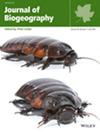To test the hypothesis that adaptive shifts leading to the assembly of tropical savannas involved coordination between bark and wood traits and to understand the underlying mechanisms.
Tropical South America.
Angiosperms (woody).
We compiled data on three bark traits (total, inner and outer relative bark thickness), wood density, maximum height, five secondary xylem traits and on species' habitat information (light environment, climate, soil and fire history) for Neotropical savanna, forest and generalist species (biome groups). We tested for pairwise and multivariate associations among traits across species and if biome group and habitat conditions explained species positions along the resulting strategy axes.
Traits covaried along four different axes. The first axis was consistent with a trade-off between fire (thick barks) and shade tolerance (low bark to diameter ratio, high vessel density) and contributed to differentiate the three biome groups according to the preference for shaded environments. Forest species also differed from savanna and generalist species in a separate axis by being more resource acquisitive. Maximum height and wood density did not strongly trade-off with bark thickness, although maximum height was negatively covaried with relative outer bark thickness. Preference for shaded conditions was the main driver of variation in the two principal strategy axes, but temperature, fire and soil sand content also explained differences in plant stature between savanna and generalist species.
Allocation to bark is constrained by trade-offs with wood, opposing shade-tolerant and acquisitive forest species to fire-resistant and conservative savanna species. Rather than a single strategy axis, three axes are necessary to understand the functional differences among savanna, forest and generalist species. Because two of these axes are controlled by light availability, the associated traits tend to covary in space and time, but not across species.


